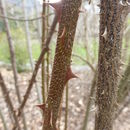en
names in breadcrumbs


Flowering from May to June; fruiting from July to August.
Rosa serocea is close relative of Rosa mairei, but differs from the latter in its leaflets ovate, obovate, or obovate-oblong, adaxially glabrous, abaxially sericeous (vs. oblong-obovate, both surfaces sericeous), hip globose or obovoid (vs. obovoid-globose).
Rosa sericea is occurring in Guizhou, Sichuan, Xizang, Yunnan of China, Bhutan, India, Myanmar, Sikkim.
Shrubs erect, 1.5-2.5 cm tall. Branchlets robust; prickles absent or in pairs below leaves and scattered, terete, up to 1.5 cm long, fine to robust, abruptly flaring to a broad base, or prickles winglike, up to 1.5 cm long, 3.5 cm wide; bristles sometimes dense. Leaves and petiole 3.5-8.5 cm long; stipules mostly adnate to petiole, free parts auriculate, pubescent or glabrous, margin glandular; rachis and petiole pubescent, sometimes sparsely prickly and glandular-pubescent; leaflets 7-13, ovate or obovate, rarely obovate-oblong, abaxially sericeous-villous or subglabrous to glabrous, glandular or not, adaxially glabrous, rugose, base broadly cuneate, margin serrate in upper part, entire below, apex rounded-obtuse or acute. Flower solitary, axillary; pedicels 1-2.5 cm long, glabrous; bracts absent. Hypanthium obovoid or globose, subglabrous. Sepals 4, ovate-lanceolate, abaxially sparsely pubescent or subglabrous, adaxially villous, margin entire, apex acuminate or acute. Petals 4, white, broadly obovate, base broadly cuneate, apex emarginate. Styles free, shorter than stamens, slightly exserted, villous. Hip red or purple-brown, obovoid or globose, glabrous, with persistent, erect sepals; pedicel glabrous, usually not fleshy.
The chromosomal number of Rosa sericea is 2n = 14 (Sandhu and Mann, 1989).
Growing in sparse woods, forest margins, scrub, sunny places; 2000-4000 m m.
Rosa sericea, the silky rose,[1] is a species of flowering plant.
The closely related Rosa omeiensis is sometimes treated as a subspecies of R. sericea.
It is native to south-western China (Guizhou, Sichuan, Xizang, Yunnan), Bhutan, northern India (Sikkim), Nepal and Myanmar; it grows in mountains at altitudes of 2,000–4,400 m (6,600–14,400 feet).
It is a shrub growing 2 m (6+1⁄2 feet) tall and is often very spiny. The leaves are deciduous, 4–8 cm (1+5⁄8–3+1⁄8 inches) long, with 7–11 leaflets with a serrated margin. The flowers are 2.5–5 cm (1–2 inches) diameter, white, with (unusually for a rose) only four petals. The hips are red, 8–15 mm (5⁄16–19⁄32 inch) diameter, with persistent sepals, and often bristly.
There are four formae:
Rosa sericea f. pteracantha is grown as an ornamental plant for its large, bright red thorns.
Rosa sericea, the silky rose, is a species of flowering plant.
The closely related Rosa omeiensis is sometimes treated as a subspecies of R. sericea.